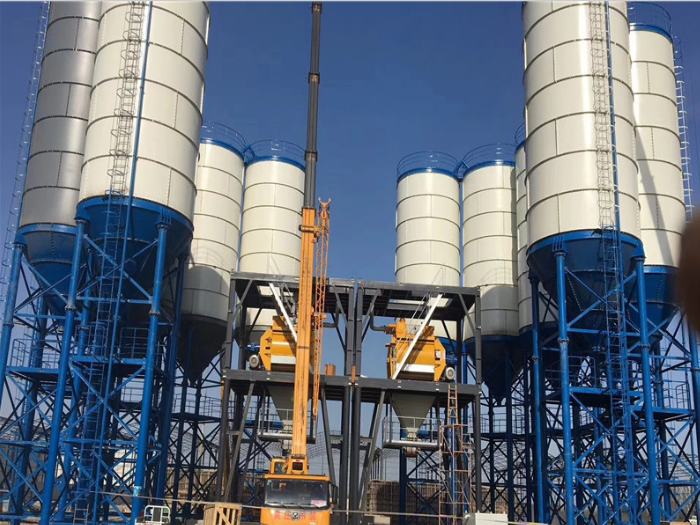Differences Between Horizontal Cement Silo and Vertical Cement Silo
The three primary types of silos are vertical, horizontal, and portable. There are Bolted & Welded Cement Silos as vertical silos and Horizontal Cement Silos. The option for those silos is portable and standard. You can customize different sizes of all of the parts on all levels if you get an offer.
Cement Storage Silos
Cement storage silos are vital supporting equipment for concrete mixing plants and stabilized soil mixing plants. They come in two main types: horizontal cement silos and vertical cement silos. These silos differ significantly in shape, material, height, and capacity in tons.
Horizontal cement silos are shaped like cuboids and constructed with U-steel for the silo body and square steel for the support legs. Their support legs are notably lower in height compared to vertical silos. On the other hand, vertical cement silos have a conical shape, with higher steel plate usage in both the silo body and round legs.
Both types are extensively used in building construction, each with its own set of advantages and disadvantages.
Vertical cement silos
Vertical cement silos are tower-like structures that store cement, lime, base, and paste mixtures. They are typically found on construction sites and can be circular or orthogonal in shape. Vertical silos can take up more space than horizontal silos and can be customized with features such as:
Butterfly valves for material discharging
Safety valve for silo pressure control
Silo level blade indicator
Blowing plant with a nozzle to facilitate the exit of materials
Customizable diverging funnel flow cone at the bottom to handle any type of load
Vertical silos are built in carbon or stainless steel and can store large quantities of powders, granules/pellets, or liquids. They are used to store materials such as cement, lime, fillers, fly ash, bentonite, and sand.
Horizontal Cement Silo vs. Vertical Cement Silo
Horizontal Cement Silo
Also known as a horizontal cement tank, the horizontal cement silo is welded from container plates, boasting high strength and excellent airtightness. Equipped with a vibration motor for smooth discharging and prevention of cement arching, it features manual butterfly valves at the discharging outlet for easy maintenance and material discharging via screw conveyor. Dust collectors atop the silo roof prevent dust pollution, while an arch-breaking device tackles arches formed by material accumulation. Coordinated use of the horizontal cement silo and screw conveying pump facilitates material transport to designated positions, making it easy to install and an ideal storage solution for mixing stations.
Vertical Cement Silo
Prior to installation, a firm foundation must be prepared for the vertical cement silo. Its lengthy installation period makes it unsuitable for construction sites requiring frequent relocation. Transporting vertical cement silos can be inconvenient, often necessitating the transportation of bulk components to the site for on-site welding and assembly due to road conditions. Furthermore, this type of silo cannot be recycled.
Taller than horizontal cement storage silos, vertical cement silos require wind and lightning protection. Height restrictions may render them unavailable in certain areas. Additionally, when fully loaded, their high center of gravity prohibits the installation of weighing systems, making it challenging to accurately measure cement weight.
Despite their differences, horizontal and vertical cement storage silos share common features. Both can store cement, fly ash, and other powdery materials, equipped with dust collectors and safety valves on the silo roof. Accessories such as safety valves, upper feeding pipes, and level meters serve similar functions. The choice between the two types depends on specific requirements and conditions.
Conclusion
Horizontal and vertical cement silos each have unique characteristics that cater to different construction requirements and site conditions. While horizontal silos offer mobility, larger storage capacities, and easy accessibility, vertical silos excel in space efficiency, gravity-based discharge, and stability. Choosing between horizontal and vertical silos depends on factors such as site layout, storage capacity, mobility requirements, and project duration.
For inquiries about cement silos or to find a reliable supplier for your construction needs, please don't hesitate to contact us. We're here to provide expert guidance and support in selecting the most suitable silo solution for your specific requirements.
When it comes to storing bulk materials such as cement, the choice between vertical and horizontal silos can significantly impact operational efficiency and site layout. Vertical silos, particularly welded vertical silos, offer a compact footprint, making them ideal for locations where space is at a premium. These structures stand tall, maximizing vertical space while minimizing the ground area they occupy. On the other hand, horizontal silos provide an alternative solution that spreads out horizontally, which can be advantageous in areas with ample ground space but height restrictions. The versatility of horizontal silo for sale options allows for flexible installation and easy integration into existing facilities.
For those seeking storage solutions that prioritize ease of transport and setup, horizontal cement silo for sale models have become increasingly popular. These silos are designed to be easily relocatable, fitting seamlessly into projects that require frequent moves or temporary setups. They often come equipped with features that enhance mobility, such as skids or trailers, making them a practical choice for construction sites that demand flexibility. Meanwhile, vertical silos continue to be favored for their high capacity and stability, offering reliable long-term storage without compromising on structural integrity. The robust design of welded vertical silos ensures durability even under challenging environmental conditions.
The decision to opt for either horizontal silo for sale or vertical silos ultimately depends on specific project requirements and site constraints. While horizontal cement silo for sale units excel in portability and adaptability, vertical and horizontal silos each bring unique advantages to the table. Vertical options tend to offer greater storage capacity within a smaller footprint, whereas horizontal silos provide more straightforward access for loading and unloading operations. By carefully considering factors like available space, material handling needs, and long-term use, businesses can make informed decisions that best suit their operational goals.















